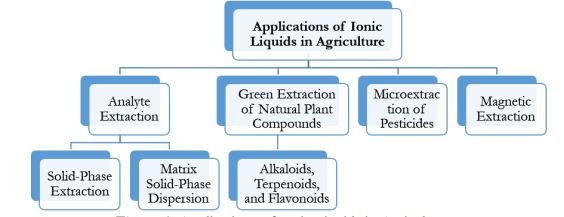Ionic Liquids in Agriculture: From Green Extraction to Sustainable Pesticide Development
Keywords:
Ionic Liquids, Toxicity of Bioactive, Micro extraction of Pesticides, Microbial Control Agents, Imidazolium CationsAbstract
Agriculture, pivotal for sustaining the global population, faces challenges in achieving efficiency, economic viability, and environmental friendliness. Nano-modified stimulants offer promise for sustainable agricultural development, crucial for addressing food security and quality. Ionic Liquids (ILs), known as "designer solvents" with unique physicochemical properties, have gained attention across diverse industries, including agriculture. The evolution of IL technology, from customizable physical properties to bioactive ILs, opens avenues for their application in agriculture, spanning extraction of natural products, pesticide isolation, ionization of active ingredients, and controlled pesticide delivery. ILs contribute to sustainable analyte extraction in modern science, offering eco-friendly alternatives to traditional solvents. In the microextraction of pesticides, ILs feature prominently in techniques like Dispersive Liquid-Liquid Microextraction (DLLME) and Single-Drop Microextraction (SDME), demonstrating advantages such as rapid extraction and high recoveries. In modern sample preparation techniques, ILs integrated into Solid-Phase Extraction (SPE) enhance speed and environmental compatibility. IL-modified materials find application in various microextraction settings, showcasing improved efficiency and environmental compatibility. Pesticides developed using ILs exhibit diverse applications, from herbicidal ILs with dual-ion systems to ILs acting as food repellents, plant growth regulators, and microbial control agents. Furthermore, ILs show promise in pesticide delivery and controlled release, advancing pesticide development for sustainable agriculture. The biodegradability and toxicity of ILs are critical aspects, necessitating a comprehensive understanding. The toxicity of bioactive ILs is influenced by factors such as cation structure and anion nature. Imidazolium cations' biodegradability has been explored, providing insights into potential environmental impacts. Addressing gaps in toxicological research, particularly regarding combined toxicity in agrochemical products, remains a challenge. While certain ILs show limited toxicity in agricultural soils, further studies on IL transport and degradation dynamics are essential. In summary, the multifaceted applications of ILs in agriculture, spanning extraction, microextraction, pesticide development, and environmental considerations, present a dynamic landscape for future research and advancements in sustainable agricultural practices.
References
S. Lago, H. Rodríguez, A. Arce, and A. Soto, “Improved concentration of citrus essential oil by solvent extraction with acetate ionic liquids,” Fluid Phase Equilib., vol. 361, pp. 37–44, Jan. 2014, doi: 10.1016/J.FLUID.2013.10.036.
J. Zhang et al., “Understanding cellulose dissolution: effect of the cation and anion structure of ionic liquids on the solubility of cellulose,” Sci. China Chem., vol. 59, no. 11, pp. 1421–1429, Nov. 2016, doi: 10.1007/S11426-016-0269-5.
A. Abdi Hassan, M. Sajid, H. Al Ghafly, and K. Alhooshani, “Ionic liquid-based membrane-protected micro-solid-phase extraction of organochlorine pesticides in environmental water samples,” Microchem. J., vol. 158, Nov. 2020, doi: 10.1016/J.MICROC.2020.105295.
Y. Wang et al., “Matrix solid-phase dispersion coupled with magnetic ionic liquid dispersive liquid-liquid microextraction for the determination of triazine herbicides in oilseeds,” Anal. Chim. Acta, vol. 888, pp. 67–74, 2015, doi: 10.1016/J.ACA.2015.07.028.
D. Lu, C. Liu, J. Deng, X. Zhou, G. Shi, and T. Zhou, “Rational design of an ionic liquid dispersive liquid-liquid micro-extraction method for the detection of organophosphorus pesticides,” Analyst, vol. 144, no. 6, pp. 2166–2172, Mar. 2019, doi: 10.1039/C9AN00123A.
S. Peng, J. Xiao, J. Cheng, M. Zhang, X. Li, and M. Cheng, “Ionic liquid magnetic bar microextraction and HPLC determination of carbamate pesticides in real water samples,” Microchim. Acta, vol. 179, no. 3–4, pp. 193–199, Nov. 2012, doi: 10.1007/S00604-012-0884-4.
“View of Evaluating Spatio-Temporal Decline to Agriculture through Satellite Imagery from 2010-2022.” Accessed: Feb. 22, 2024. [Online]. Available: https://journal.50sea.com/index.php/IJASD/article/view/471/971
A. Gubin, P. Sukhanov, A. Kushnir, K. Shikhaliev, M. Potapov, and E. Kovaleva, “Ionic-liquid-modified magnetite nanoparticles for MSPE-GC-MS determination of 2,4-D butyl ester and its metabolites in water, soil, and bottom sediments,” Environ. Nanotechnology, Monit. Manag., vol. 17, May 2022, doi: 10.1016/J.ENMM.2022.100652.
H. Wang et al., “A rapid and simple pretreatment method for benzoylurea insecticides in honey samples using in-syringe dispersive liquid–liquid microextraction based on the direct solidification of ionic liquids,” J. Chromatogr. A, vol. 1471, pp. 60–67, Nov. 2016, doi: 10.1016/J.CHROMA.2016.10.027.
Y. Jiang, Z. Wang, Z. Lei, and G. Yu, “Structural effects on thermodynamic behavior and hydrogen bond interactions of water–ionic liquid systems,” Chem. Eng. Sci., vol. 230, Feb. 2021, doi: 10.1016/J.CES.2020.116186.
L. Zhang et al., “Separation and concentration of sulfonylurea herbicides in milk by ionic-liquid-based foam flotation solid-phase extraction,” J. Sep. Sci., vol. 38, no. 10, pp. 1733–1740, May 2015, doi: 10.1002/JSSC.201401344.
F. Galán-Cano, R. Lucena, S. Cárdenas, and M. Valcárcel, “Dispersive micro-solid phase extraction with ionic liquid-modified silica for the determination of organophosphate pesticides in water by ultra performance liquid chromatography,” Microchem. J., vol. 106, pp. 311–317, Jan. 2013, doi: 10.1016/J.MICROC.2012.08.016.
S. C. Zhu, M. Z. Shi, Y. L. Yu, and J. Cao, “Simultaneous extraction and enrichment of alkaloids from lotus leaf by in-situ cloud point-reinforced ionic liquid assisted mechanochemical extraction technology,” Ind. Crops Prod., vol. 183, Sep. 2022, doi: 10.1016/J.INDCROP.2022.114968.
N. Nasirpour, M. Mohammadpourfard, and S. Zeinali Heris, “Ionic liquids: Promising compounds for sustainable chemical processes and applications,” Chem. Eng. Res. Des., vol. 160, pp. 264–300, Aug. 2020, doi: 10.1016/J.CHERD.2020.06.006.
J. Yang et al., “Synthesis and application of imidazolium-based ionic liquids as extraction solvent for pretreatment of triazole fungicides in water samples,” Anal. Bioanal. Chem., vol. 410, no. 6, pp. 1647–1656, Feb. 2018, doi: 10.1007/S00216-017-0820-X.
X. Peng, X. Sui, J. Li, T. Liu, and L. Yang, “Development of a novel functionality for a highly efficient imidazole-based ionic liquid non-aqueous solvent system for the complete extraction of target alkaloids from Phellodendron amurense Rupr. under ultrasound-assisted conditions,” Ind. Crops Prod., vol. 168, Sep. 2021, doi: 10.1016/J.INDCROP.2021.113596.
M. G. Freire, C. M. S. S. Neves, I. M. Marrucho, J. N. Canongia Lopes, L. P. N. Rebelo, and J. A. P. Coutinho, “High-performance extraction of alkaloids using aqueous two-phase systems with ionic liquids,” Green Chem., vol. 12, no. 10, pp. 1715–1718, Oct. 2010, doi: 10.1039/C0GC00179A.
D. C. Murador, L. M. de Souza Mesquita, N. Vannuchi, A. R. C. Braga, and V. V. de Rosso, “Bioavailability and biological effects of bioactive compounds extracted with natural deep eutectic solvents and ionic liquids: advantages over conventional organic solvents,” Curr. Opin. Food Sci., vol. 26, pp. 25–34, Apr. 2019, doi: 10.1016/J.COFS.2019.03.002.
C. W. Cho, T. P. T. Pham, Y. Zhao, S. Stolte, and Y. S. Yun, “Review of the toxic effects of ionic liquids,” Sci. Total Environ., vol. 786, Sep. 2021, doi: 10.1016/J.SCITOTENV.2021.147309.
M. Gao et al., “Ionic-liquid-based effervescence-enhanced magnetic solid-phase extraction for organophosphorus pesticide detection in water samples,” Anal. Methods, vol. 14, no. 6, pp. 661–671, Feb. 2022, doi: 10.1039/D1AY01698A.
M. Z. Shi, Y. L. Yu, S. C. Zhu, J. Yang, and J. Cao, “Latest Development of Matrix Solid Phase Dispersion Extraction and Microextraction for Natural Products from 2015-2021,” Sep. Purif. Rev., vol. 52, no. 3, pp. 262–282, 2023, doi: 10.1080/15422119.2022.2094274.
J. P. Hallett and T. Welton, “Room-temperature ionic liquids: Solvents for synthesis and catalysis. 2,” Chem. Rev., vol. 111, no. 5, pp. 3508–3576, May 2011, doi: 10.1021/CR1003248.
M. Li, C. Yang, H. Yan, Y. Han, and D. Han, “An integrated solid phase extraction with ionic liquid-thiol-graphene oxide as adsorbent for rapid isolation of fipronil residual in chicken eggs,” J. Chromatogr. A, vol. 1631, Nov. 2020, doi: 10.1016/J.CHROMA.2020.461568.
X. Song et al., “Research progress in the sample pretreatment techniques and advanced quick detection methods of pesticide residues,” Process Saf. Environ. Prot., vol. 165, pp. 610–622, Sep. 2022, doi: 10.1016/J.PSEP.2022.07.047.
L. Vidal, M. L. Riekkola, and A. Canals, “Ionic liquid-modified materials for solid-phase extraction and separation: A review,” Anal. Chim. Acta, vol. 715, pp. 19–41, Feb. 2012, doi: 10.1016/J.ACA.2011.11.050.
D. Han and K. H. Row, “Recent applications of ionic liquids in separation technology,” Molecules, vol. 15, no. 4, pp. 2405–2426, Apr. 2010, doi: 10.3390/MOLECULES15042405.
P. O. Boamah, L. Wang, W. Shen, S. Tang, and H. K. Lee, “Applications of ionic liquids in the microextraction of pesticides: A mini-review,” J. Chromatogr. Open, vol. 4, p. 100090, Nov. 2023, doi: 10.1016/J.JCOA.2023.100090.
L. Yang et al., “Ultrasound-assisted extraction of the three terpenoid indole alkaloids vindoline, catharanthine and vinblastine from Catharanthus roseus using ionic liquid aqueous solutions,” Chem. Eng. J., vol. 172, no. 2–3, pp. 705–712, Aug. 2011, doi: 10.1016/J.CEJ.2011.06.039.
X. Y. Lin, R. X. Mou, Z. Y. Cao, Z. Z. Cao, and M. X. Chen, “Analysis of pyrethroid pesticides in Chinese vegetables and fruits by GC–MS/MS,” Chem. Pap., vol. 72, no. 8, pp. 1953–1962, Aug. 2018, doi: 10.1007/S11696-018-0447-1.
M. Andraščíková, E. Matisová, and S. Hrouzková, “Liquid phase microextraction techniques as a sample preparation step for analysis of pesticide residues in food,” Sep. Purif. Rev., vol. 44, no. 1, pp. 1–18, 2015, doi: 10.1080/15422119.2013.872125.
K. D. Clark, M. J. Trujillo-Rodríguez, and J. L. Anderson, “Advances in the analysis of biological samples using ionic liquids,” Anal. Bioanal. Chem., vol. 410, no. 19, pp. 4567–4573, Jul. 2018, doi: 10.1007/S00216-018-0898-9.
B. Herce-Sesa, J. A. López-López, and C. Moreno, “Advances in ionic liquids and deep eutectic solvents-based liquid phase microextraction of metals for sample preparation in Environmental Analytical Chemistry,” TrAC - Trends Anal. Chem., vol. 143, Oct. 2021, doi: 10.1016/j.trac.2021.116398.
D. J. Eyckens and L. C. Henderson, “A review of solvate ionic liquids: Physical parameters and synthetic applications,” Front. Chem., vol. 7, no. APR, 2019, doi: 10.3389/FCHEM.2019.00263.
Q. Li et al., “Ultrasonic-assisted extraction of sinomenine from Sinomenium acutum using magnetic ionic liquids coupled with further purification by reversed micellar extraction,” Process Biochem., vol. 58, pp. 282–288, Jul. 2017, doi: 10.1016/J.PROCBIO.2017.04.030.




